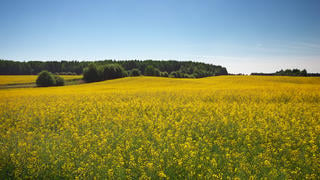The Impact of Food on Global Warming
10 min read
Just like housing and transportation, the food industry is an essential component of human society. As is the case with these two sectors, the food supply chain – which encompasses farming, ranching, fishing, processing, distribution and consumption – consumes energy and releases greenhouse gas emissions, thereby contributing to . Inevitably making the situation even more difficult, the global population is projected to grow by two to three billion people by 2050.

© Thinkstock - Agricultural and forest land can both emit and capture greenhouse gases.
Human activities related to land use are varied and diverse, ranging from agricultural production and ranching to forest management, urbanization and regional infrastructure development. According to 2014 estimates from the , these activities are responsible for 24% of anthropogenic greenhouse gas emissions (GHG) worldwide1. Contrary to other sectors of the economy, this percentage has decreased and stabilized in the past 10 years.
The IPCC divides anthropogenic GHG emissions into three major categories:
- 10% caused by changes in land use. This occurs when forests are cleared or wetlands destroyed to accommodate crops or livestock, or when rural land is converted for industrial, transportation or urban uses. These changes affect the land’s capacity to act as a natural . According to the Food and Agriculture Organization2 (FAO) of the United Nations, the situation has improved, with emissions due to land-use change declining by nearly a tenth over the 2001-2010 period.
- 11% directly related to farming and ranching. FAO estimates show that agricultural emissions could increase by one third by 2050, barring sufficient efforts to make farming and ranching more sustainable. There is a striking regional disparity however: emissions are decreasing in the developed world but increasing in the emerging economies.
- 3% caused by other factors, such as peat decay and forest fires.
If one considers the entire food chain, it’s also necessary to include emissions from the food industry, transportation, packaging and distribution. Emissions vary widely from one continent and country to another, depending on their level of development and societal attitudes. In the developed nations, emissions from the field to the plate account for at least 30% of total anthropogenic emissions, which means that the food system contributes as much to GHGs as transportation and housing.
Gas Emissions and Their Sources
In energy production, housing, manufacturing and transportation, carbon dioxide (CO2) is the dominant GHG. In the food chain, however, the primary emissions are methane (CH4) and nitrous oxide (N2O), two equally potent GHGs, while CO2 ranks third. (See box below: “Greenhouse Gas Overview”).
The main emission is methane, which is produced by the digestion of plant matter by ruminant animals, such as cows and sheep, as well as by manure. Rice paddies, like all wetlands, also generate significant amounts of methane. CH4 accounts for roughly half of all agricultural emissions.
Nitrous oxide is created by the transformation of nitrogen compounds, which are abundant in fertilizers, manure and crop residues. It’s the fastest growing source of GHG emissions due to the increasing use of fertilizers (up approximately 37% since 2001).
CO2 emissions are chiefly generated by the combustion of fuels to farm equipment and produce fertilizer.
The gases have different effects when they are released into the atmosphere. They differ according to their trapping capacity and the time they remain in the air. Methane, for example, has a global warming potential that is 27 times greater than that of carbon dioxide, but its life span is shorter: about 12 years. CO2 remains in the atmosphere for a long time: 100 years for the elimination of more than half its volume, but more than 10,000 years for the elimination of the last fraction. Nitrous oxide combines both disadvantages: its warming potential is 273 times that of CO2, and it persists in the atmosphere for more than 110 years.
Greenhouse Gas Overview
A
is a gas in the atmosphere that absorbs infrared radiation emitted by the Earth’s surface. Nitrogen (78%) and oxygen (21%), the two most abundant gases in the atmosphere, are not greenhouse gases.
The most prevalent GHG is water vapor. We’re seeing an increase in the amount of water vapor in the atmosphere, which seems to be directly and quantitatively related to the rise in temperature, since warm air contains more water vapor than cold air. The water vapor effect contributes marginally to the
.
Carbon dioxide (CO2) – Carbon dioxide is the biggest contributor to GHG emissions. A significant quantity of carbon emissions come from natural sources, such as animal respiration, the decay of organic matter, natural fires and the evaporation of oceans. These emissions are offset by natural carbon sinks. But human activities also generate large amounts of CO2. Fossil fuel consumption, industrial processes (cement works for example) and human-induced deforestation are among the main culprits. CO2 accounts for more than 55 % of additional greenhouse gases due to human activities.
Methane (CH4) – Methane is called natural gas. It is produced by the
decomposition of organic compounds (plant or animal) through the process of
or decay. The most common sources are marshes, wetlands, livestock and termites. Methane is also emitted by humans engaged in ranching and rice farming, as well as in
mining, oil and gas operations associated with gas leaks. Methane is responsible for just over 15% of anthropogenic greenhouse forcing.
Nitrous oxide (N2O) – Nitrous oxide, or laughing gas, is used in seltzer bottles among other things. It is naturally emitted in wetlands. Anthropogenic N2O emissions are mainly caused by nitrogen fertilizers used in farming. N2O accounts for roughly 5% of anthropogenic GHG emissions.
Ozone (O3) – Found in the stratosphere more than 10 kilometers above the Earth, ozone absorbs the sun’s ultraviolet rays. It forms what is called the ozone layer, which can develop holes due to human activity. In the troposphere, however, at an altitude of less than 10 kilometers, ozone is a strong oxidant that can cause lung damage. That is why countries sometimes issue ozone alerts. Anthropogenic emissions are predominantly linked to the consumption of oil, gas and derivative products. Tropospheric ozone accounts for about 10% of anthropogenic GHG emissions.
The other GHGs are produced by industrial processes. They mainly concern halocarbons, which are compounds that contain carbon and a halogen, such as fluorine or chlorine. Halocarbons account for just over 10 % of anthropogenic GHG emissions. The halocarbon family includes chlorofluorocarbons (CFCs), which are used in air conditioning systems, computers, telephones and, previously, spray cans. The problem with CFCs is twofold: they contribute to the greenhouse effect and deplete the ozone layer. That is why CFC production has been phased out since the signing of the Montreal Protocol in 1987.
Lastly, sulfur hexafluoride (SF6), a member of the fluorinated gas family, is found in electrical equipment and certain building materials, such as double-glazed windows. While its emissions are low, SF6 is even more absorbent and resistant than halocarbons.





















